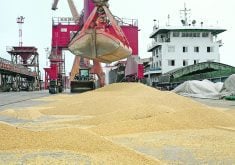Like giant cargo ships, the big economies of the world have sailed through stormy seas for several years and finally calmer water might be ahead, but the crews are in a foul mood and are not about to salute their captains.
In Canada, the United States and elsewhere, the chaos from COVID-19 and the Russian invasion of Ukraine that plagued supply chains has mostly calmed, the rate of inflation is falling to a more normal level and central banks are starting to trim interest rates.
A sea captain might say, “good news, we avoided the reefs and did not capsize.”
Read Also

Livestock leads Canada’s farm economic outlook
Forecasts by a major Canadian farm lender featured good and bad news on the financial health of both farmers and Canadians at large.
The politician and central banker might say, “good news, we avoided recession, and unemployment did not soar.”
But the crew says, “our quarters are soaking wet, we’re exhausted and the food supply is short.”
Most consumers say the cost of living, from food to rent to mortgage payments, has soared and it’s hard to pay the bills.
The question now is, has the captain’s latest steering set the ship on a safe course or is he spinning the wheel too late to avoid new dangerous shoals?
Statistics Canada last week reported that the consumer price index — in other words, inflation — in July was up 2.5 per cent from a year ago, the smallest increase since March 2021.
In the U.S., July inflation was at 2.9 per cent, also the lowest since March 2021.
In both countries, the jobs market is cooling, good news for inflation but also a worrisome sign that some businesses are struggling.
Up on the bridge, the captains, in this case the central banks, are course correcting.
The Bank of Canada cut its key rate in June and July, each time by 25 basis points. The rate is now 4.5 per cent, down from five in May.
U.S. Federal Reserve chair Jerome Powell last week signalled a rate cut in September. Most expect a 25 basis point cut. Likely both banks will make further cuts this year.
Did they leave it too late? Will they cut fast enough to avoid recession?
And what does this mean for inflation?
Most average Joe consumers want prices to return to where they were before all this upset.
They will likely be disappointed. Retail prices, taken as a whole, rarely fall.
In Canada, inflation has fallen to zero or below only three times in the last 35 years — in the early 1990s, in 2009 and in 2021.
Each case was brought on by recession: a shrinking economy that caused business failures and soaring unemployment.
The causes of the early 1990s recession included high interest rates designed to cool inflation, high oil prices and in the United States the savings and loan financial institution crisis. In Canada the introduction of the goods and services tax staggered business.
The people were angry.
In the U.S. 1992 presidential election, George W. Bush lost to Bill Clinton, whose campaign slogan was, “it’s the economy, stupid.”
In Canada, the governing Progressive Conservatives were nearly wiped out in the 1993 election.
The late 2000s Great Recession was global. Causes included the U.S. housing bubble, the failure of global financial institutions and a resulting pull back in commercial lending.
People were angry that governments and institutions allowed policies that helped trigger the economic collapse, and many thought the responses to it were inadequate. Recovery was slow and in retrospect, many economists felt more government stimulus would have helped.
Trust was broken and suspicion of elites increased, giving rise to populism on both sides of the political spectrum and increasing societal division.
The brief 2021 recession was caused by COVID-19 and the shutdowns around the world designed to stop its spread. Governments took a lesson from the last recession and increased stimulus spending, but went too far in that direction.
Each recession was enormously painful and while they might have frozen or slightly decreased the cost of goods, prices did not return to where they were before.
So although most people want prices to fall, they likely don’t want a recession that would cause them to dip.
The best to hope for is that central bank rate cuts come fast enough to avoid recession while keeping inflation at a normal rate of around two per cent. Wages slowly catch up and we all become comfortable with what could be called a “new normal,” just like people did in the late 1980s and early 1990s after the run of exceptionally high inflation of the late 1970s and early 1980s.
Commodity pricing is different than retail. Prices do swing up and down.
The hope for farmers is that with a steadier economy, the cost of input commodities, such as fuel and fertilizer, balance with output commodities, such as grain and livestock, leaving producers with margins that provide a reasonable living.















